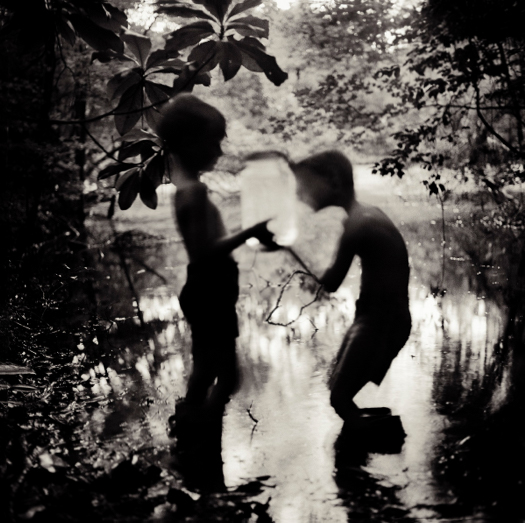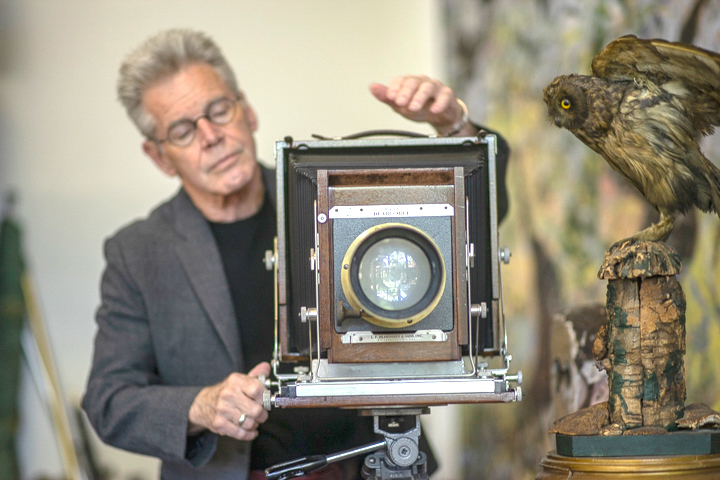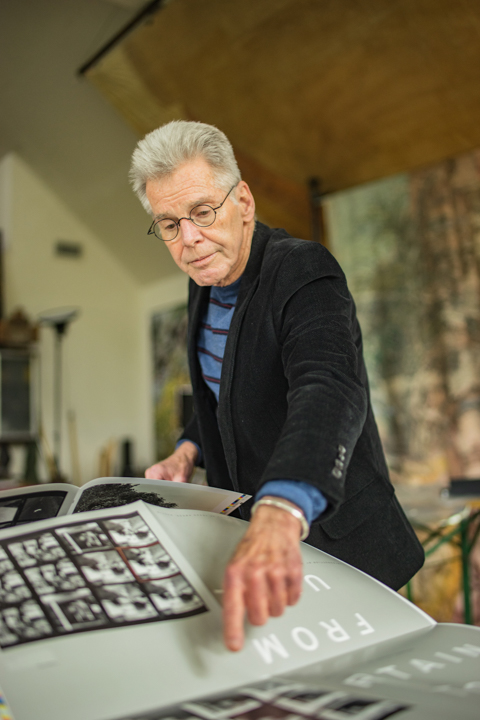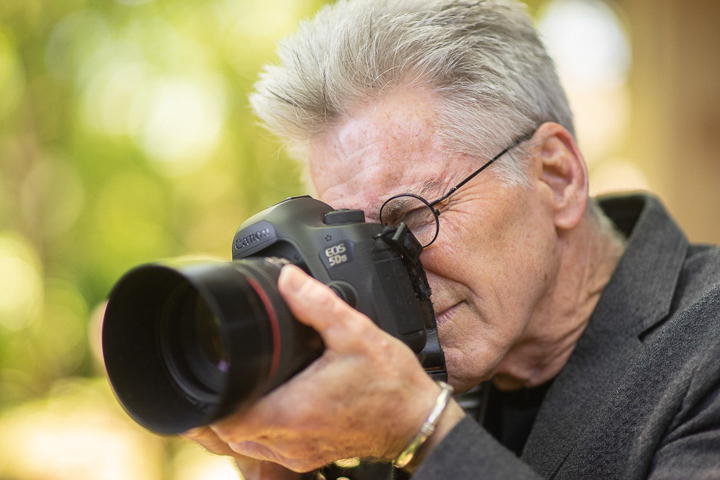
“Fireflies,” above, is one of the photos that made Carter famous.
His unique style reached photographers around the country who immediately sought to
hire Carter to produce the same kind of work.
Picture a little boy around the age of five standing outside, a brown Hawkeye camera around his neck as he snaps frame after frame. Fast forward about 15 years and picture that same little boy, now a young adult, standing, new camera in hand in front of a calm river where a few fishermen cast their rods in the hazy glow of sunset.
Photographer Keith Carter, a cup of tea in his hand, surrounded by the accomplishments of a successful career, describes the first time a camera was put in his hands, and the moment he fell in love with photography.
“Well, I have a photograph from when I was five,” he said. “I don’t really remember a lot about how I got that camera, but I think my mom, who had been a photographer, must have given it to me for my birthday or Christmas.”
Carter was studying business at Lamar University when he took a class that changed his life.
“I was a business major, but I wasn’t particularly interested in that, so I took one art course that I loved,” he said. “It was a design course and my mother had always been a professional photographer. We were a single parent household since I was five, and I went back and asked her if I could borrow her camera and she said yes. I went down to the river and photographed some guys fishing. It wasn’t a great picture, but it’s probably my first serious thing.
“I had them processed and she said, ‘Well honey, you have a good eye, you have a nice sense of light,’ and I tell people it’s probably just good parenting that kind of put me on the right track. I thought ‘OK, I have a good eye.’”

Carter recalls his childhood fondly as he remembers his mother, a strong single parent who owned her own photography studio.
“When my father left, she started a small studio,” Carter said. “She had been, as a college girl, a photographer of other college girls. She would travel around the Midwest. So, I grew up around it. She always had a small studio and she always worked hard. I was mostly interested in the things guys are interested in and it wasn’t art at that time — guitars, Cadillacs, hillbilly music and all that kind of stuff.”
Carter said he truly fell in love with photography after that first design course and started his journey as a self-taught photographer at the age of 20.
“In the beginning, like a lot of people, we didn’t have photography courses out at Lamar, so I pretty much was self-taught,” he said. “I spent a lot of time getting books from the library and whoever’s book I got, I would be them for a while — I would just replicate them. I did that for almost 10 years while I learned everything I could learn. I did all the little jobs I could do around here at the same time, and then I took a bus trip to New York.”
Carter said the decision to hop on that bus to New York at the age of 22 shaped his life and set the course for the rest of his career.
“I wrote the Museum of Modern Art and asked them if I could come up and see their collection, that I was a serious scholar,” he said. “I got a letter back from them that said, ‘Yeah, you can come up. Who do you want to see?’ I only knew three or four photographers, and so I sold everything and took the Greyhound bus to New York City in February. It was the least expensive way to get there. I thought I had enough money to stay a month, but I lasted about three weeks and it was cold.
“But I saw all these great prints, and for me to see the people whose work I’d really admired, and that the museum collected, see where they spotted and did little things and it was exciting — it changed my life.
“However, the thing that really changed my life was when I first got off the bus at the terminal. I had never been there. It’s February, it’s snowing. I was going to walk down to the Village, and I passed a skinny guy in an overcoat with a fat cat and he had a sign around his neck that said, ‘Poems, $1.’ I walked right by because my dollars were precious and then I thought, ‘Oh, that’s bad karma.’ So, I went back and bought the first poem on his list, and the first poem on his list was ‘Rock Your Ass Off,’ which consisted of non-rap before the rapping stuff. All he did was shout at the top of his voice, ‘Rock your ass off,’ about 40 times.”
Carter said as he sat on the bus on his way back to Beaumont, the one thing that kept replaying in his head was his encounter with the man and the poem he had bought.
“I’m on the bus riding back home after I’ve seen all these great things and I thought, ‘I’m going to get really focused and I’m going to work really hard and I’m going to rock my ass off,’ he said. “It’s a metaphor, but I still think that today. Whatever keeps you working in a focused direction, that’s like a mantra — just go rock your ass off.”
When Carter returned home, he said he was ready to pour all of his assets and hard work into his career and build the life he wanted for himself. He found immediate inspiration in his hometown.
“I decided, particularly when I came back from New York, that where I live is flat, tangled, deeply green, hurricanes roll in, you have four out of the five poisonous snakes in North America and three out of the four carnivorous plants,” he said. “You have white Anglo-Saxon Protestants. You have black imagination. You have Vietnamese industry. You have mexican mythology, crackers, peckerwoods and rednecks, all in this gumbo culture, and I thought, ‘My God, that should be my subject matter.’

Carter flips through the original prints of his first book,
“From Uncertain to Blue,” a book that helped him find his personal
style as a photographer and included photos from 100 unusual places in Texas.
UP photo by Noah Dawlearn
“I thought, I should just photograph my own roots — and that’s the first time anybody started paying attention to my work. It didn’t look like anybody else’s, or not too many people’s anyway. That is why my career started to evolve.”
Carter’s photographs of Southeast Texas were compiled in the book, “From Uncertain to Blue.”
“Once I did that first little book, all of a sudden people all around the country, art directors, would hire me to go do stories or do something — this is before I started teaching at Lamar,” he said. “The reason they hired me was because I had a certain kind of style, not because I was the best photographer. I just looked at things in a certain way and I started to take this place with me. I tried to make the same kinds of photographs everywhere I was, and so it just evolved through books, looking at art, reading poetry. After a while you just become yourself.”
The book grew from a project that was originally meant as an anniversary gift to his wife Pat.
“My little book started out as a whim 30 years ago just as a 10th anniversary present to my wife,” he said. “I was trying to think of something that she’d like to do rather than buying champagne or something, so I suggested we take off every weekend for a year, drive around and visit 100 small places in Texas that had unusual names. So, we did. We ended up spending two years doing that. “Two of the towns were called Uncertain, which is not far from here, and Blue. The book was called ‘From Uncertain to Blue,’ and when that came out, I didn’t really anticipate it being a book. It was just a sort of a thing to do that was pleasurable with her. But when that book came out all kinds of things happened. That’s at an era before books were online all the time. It was print and like the Holy Grail in my world.
“What happened was that all these high-powered photographers in Seattle or Chicago or Los Angeles got that book, and because it was so different from what they did, they would end up sending it as a gift or a thank you to art directors and different magazines that had sent them on jobs. I learned this later. Then the art directors would give me a call and say, ‘Would you like to come do this kind of job?’ based on that book. Then things started to happen, and you know, they kept talking amongst themselves for a long time and even after I start teaching, I would do what we call editorial work. Most the time I was hired because I made a certain kind of ragged picture rather than a certain kind of pretty picture. It was kind of ironic the whole way that it evolved.”
Carter said what he loved about the experience was that he also found his love for black and white photography and began to develop his own sense of style. Before that, he said he was just practicing other photographers’ styles.
“I personally think it takes a while to find your own style,” he said. “You have to try out a lot of things, and you have to find people whose work that you admire and try out their styles a little bit. After a period of time, when you assimilate those things, it seems to me it’s just a natural involvement that you start to find your own pathway — but you want to have something to say. You want to have a reason to make the images. But, for 10 years, I was everybody, I tried them all out.”
Carter said he fell in love with black and white because of its longevity, aesthetic and romance.
“I was always in love with black and white,” he said. “Today, color’s the default. I love color, too, but there’s something electrifying to me about black and white. For one thing, it didn’t have the seduction of color, it was really like writing a Japanese haiku as opposed to a long lyrical poem. It renders light to me in a more beautiful manner.
“Another thing that interested me was that black and white photographs, properly done, would last up to 2,000 years. Color at that time had an informational life of about 40 years before they faded, so part of it was aesthetic. The other part was it just electrified me. I just loved looking at things. It was like looking at something for the first time when you printed it in black and white, and the longevity interested me — aesthetics and longevity.”
After “From Uncertain to Blue” became a hit, Carter published several other books, including “Bones,” “A Certain Alchemy,” and “Fireflies.” A new collection, “Keith Carter Fifty Years,” spans his half-century career.
“My 50-year book came out, and if you were me, you’d be really pleased,” he said. “First of all, I can’t believe it’s been 50 years because you don’t feel that much differently, but I can look back now and see how things evolved. When I was younger, I couldn’t see how all these things would evolve, it was just what I wanted to try and do and there’s a difference.
“I came from the generation and the temperament where I didn’t really care so much about the money, I just really wanted to have an interesting life and I wanted to do interesting work. I married an interesting and smart woman, and one thing happened after another, and here we are — it’s kind of miraculous.”
While Carter loves Texas, he said one thing he likes about his profession is the opportunity to travel. He has worked in Scotland, Ireland, Wales, Great Britain, Italy, France, Monaco and the Czech Republic. He will soon visit Japan.
“I think that travel is a good way to renew yourself,” he said. “The irony is, I don’t try to make pictures about where I am, so much as I try to make pictures that just happen to take place where I am, and there’s a distinction. You try to make pictures that are something rather than about the place. That’s like National Geographic stuff. That’s about the place and they make some beautiful photographs.
“But I don’t generally make beautiful photographs — I make interesting photographs.”
Carter said he feels like he accomplished exactly what he set out to do when he made that chilly trip to New York.
“My life has been extraordinary,” he said. “I’ve been doing it now for 50 years and it’s still extraordinary — it’s been great. Photography is the most exciting thing to me. There is a certain romance to it, processing all your own film, using beautiful papers, working under orange light, the sound of running water — I love it all.”
Darkroom to Digital

Carter spent many years in a darkroom, feeling the run of water in his hands, waiting patiently for his prints to appear and spin film through his standing camera. As years turned into decades, the process changed from darkroom to digital. While Carter said he felt fortunate for his upbringing in that era, he also embraces the change and sees it as a new and different way to love his art and all its changing methods.
Carter used to use, and still often dabbles with, a Deardorff 8x10 folding view camera from the 1950s, but as the digital age progressed, he has switched to a handheld digital Canon 5DS.
“Part of my love, and that’s true of anybody that loves whatever medium they choose, I love the history of how this all evolved,” he said. “If you look at the history of photography, one process has always supplanted another process as it evolved. The irony is that none of them have ever really gone away. In fact, there’s probably more interest in antiquarian and historical processes than ever before.
“I think of the digital world as a natural evolution. I come out of the darkroom tradition. I still spend at least one day a week in the darkroom, and I love the sound of running water, precious metals, mysterious chemistry. I love all of that. On the other hand, I use digital a lot, too. It allows you to do things more rapidly, and it allows you to put together images that you really probably couldn’t do in the analog world, in terms of compositing and things like that.
“I think it’s pretty miraculous. I feel thankful that I’ve had the experience of coming up in the historical dark room and working in it, and to live through this.
“I think of the digital world like a bazillion angels on the head of a pin — it’s really amazing. I think it’s a wonderful step up. I’m really not interested in the perfection and the process as much as I am in the possibilities of what it’ll let you do — there’s a difference. I’m a big fan. I’m on my way to Japan next month and I’m all I’m going to do is take digital.”
